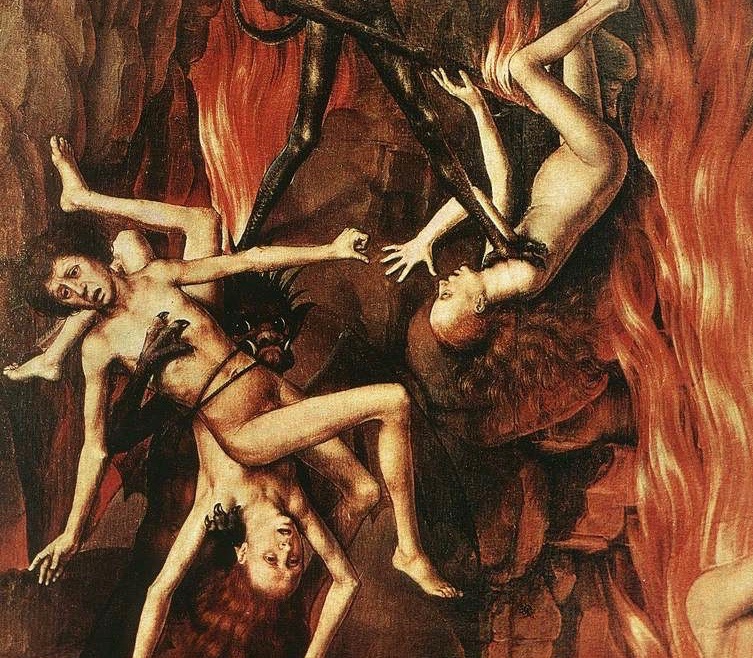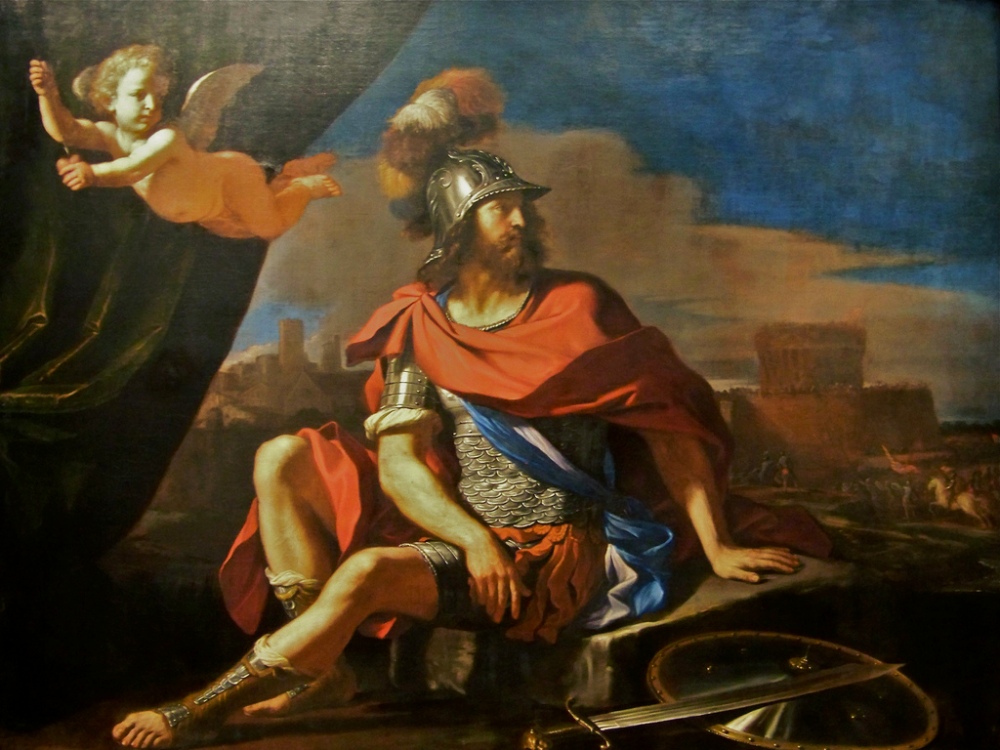Let us imagine a hypothetical towheaded Scandinavian boy born in the 5th century A.D. He is a simple villager cut off from any knowledge of Christ, yet he is as innocent as the driven snow. Let us imagine he receives a perfect picture of the God in his dreams. Immediately he becomes devoted to him. Let us imagine this picture is perfect except for one detail, Christ’s name. The boy has received a different name, perhaps a Scandinavian name. There can be no doubt, into the fiery pit this boy goes.
It actually serves a vital purpose that Christianity insists that Jesus be referred to by his name, Jesus, and that one is forced to have a specific name for this God. This is JEM. With the name Jesus, one not merely bows to Jesus, he bows, specifically, to a Jewish God of Jewish invention. Moreover, he bows to the humiliating suggestions of racial domination implicit in that mythical figure explicated in this study. It would be unacceptable for him to invent his own name for a God with identical characteristics.
Each Christian speaks disparagingly of nominal Christians or Christians in “name only.” However, as it concerns the JEM, adopting the name and declaring allegiance to the name of the savior is by far the most important step. Arguably it is the only requisite step. We are obligated to be equally fastidious. Apollo, the Hyperborean, is The Aryan God.

COMMON NAMES APPEARING IN JEM AS ETHNIC IDENTIFIERS
Here it is useful to list common names and name meanings that indicate either Jew or Aryan in the JEM. Knowing this, after all, renders narrative coherent from any meaningful perspective. We will call these names, and other symbols that serve the same purpose, Jewish or Aryan Identifiers.
While all of these names and the symbols and personages they reference require further explication, it seems useful to have a ready list. The personal name naming trends below apply to both first names and surnames appearing in contemporary JEM. This list, of course, is not exhaustive, yet it does identify central and significant trends.
As everywhere in JEM, messaging is contextual, and ethnic identify of characters needs to be corroborated against other clues. As described, as well, efforts are taken to disrupt pattern recognition by out-groups, hence Aryan or Jewish identifiers, including names, may be used as ruses to throw the decoder “off the scent.” Again, the parabolist is obliged to leave the necessary clues, which must be decipherable, so as to transmit JEM. Hence in theory every meaningful parable containing JEM is decipherable. This has proven the case in my study with necessarily deals with a finite group of texts.
Names Indicating Aryan Characters or “Aryan Identifiers”
Names indicating Aryan characters include forms of Michael, Jacob, Benjamin, Mary, Jonathan, Joseph and Jonah. References to beauty, references to the Aryan Celestial Gods, for instance, the God Mars, Apollo, references to noble or patrician classes, references to the following figures: archers, wolves, angels, farmers, gardeners or Adam. These names also include references to the color white, to enclosures, the sky, wood, trees (particularly those associated with celestial gods while excepting those associated with Chthonic Gods such as willows and poplars — trees with aggressive root systems often considered parasitic).
These names also include references to water, rivers, lakes or seas, and vaginal references in the case of women. Water here though should be understood as a liminal element where interaction between Semite and Aryan occur, hence contextual clues become important. Salt is understood in the JEM as a Jewish element. Hence a reference to saltwater, for instance, may indicated Judaization, which is understood as a kind of “salting.”
References to water may indicate submissiveness, openness to admixture or collaboration. These references may especially be references to the river Jordan and the Sea of Galilee, two bodies of water with enormous symbolic importance to Jewish Esotericists. With the possible exception of references to the name Mars, none of the above names imply an adversarial relationship to Jewish goals. Indeed, Aryan characters with the above names are often depicted as submissive to Jewish goals.

Names Indicating Jewish Characters or “Jewish Identifiers”
Names indicating Jewish characters include forms of John, David, Peter, Samuel, Thomas, Nathanael and Bartholomew. These names include references to Frankish nobility. For instance, forms of Karl, Frank or Franklin. These names include forms of Katherine (particularly as a reference to Hecate or Trivia). These names include references to Dragons or serpents. These names include phallic references (in the contemporary context Rogers, Richard, Dick, etc). These names include names indicating the wearing of a crown or laurel such as Steve and Lawrence.
These names include references to fire, smoke, clouds, stone, rocks and vines. These names include references to the color black. These names include references to singing or exultation. These names include references to the “Son of Man” like the surname Anderson. These names include references to Chthonic deities especially Saturn, Bacchus, Vulcan and Mercury. These names include Freemasonic references, Frankish references and references to Robert the Bruce. These names include references to willow trees, poplar trees and trees related to Chthonic deities.
Names referencing racial cuckoldry against Aryans
Names referencing ravens, nightingales or mythological figures such as Cassandra, Coronis and Philomela who are known for rejecting the advances of Aryan Gods such as Apollo or Mars are often used to identify figures admixing with Jewish figures or “racially unfaithful” Aryan figures. Likewise they may be used to indicate Judaization or may appear as Jewish identifiers particularly among female figures.
Names indicating Catholic Characters
These names include references to, obviously, the Catholic priesthood, and references to Rome more generally. Here though contextual clues must be closely evaluated.
Names Indicating Freemasonic Characters
These names include forms of Bruce or references to Robert the Bruce. These names also include forms of Scott as a reference to the Scottish Rites. The name Bruce likely simply indicates Jew, consistent with an esoteric understanding of Robert the Bruce. The name Scott, may or may not also simply indicate Jew but my study thus far suggests it does. This would suggest the esoteric belief that “true” inner circle Scottish Rite initiates were Jews or merely that Freemasonry was simply a Jewish phenomenon, which clearly it was.
Names Indicating Wealth
Names indicating wealth particularly coupled with a notion of guardianship are not exclusive to Aryans or Jews in JEM. Rather often they simply represent wealth status. Doubtlessly as well, they frequently indicate possessors of vied for resource.
Names Given to non-Whites, non-Jewish Characters
Naming patterns found with non-Jewish and non-Whites tend to be more contextual or parable specific in meaning. This indicates them as a lesser consideration. Though the presence of these characters is smaller and thus trends more difficult to establish. Generally, however, the names indicate them as allied with Jews or functioning as proxies. The names frequently indicate servitude to Jews possibly fitting a Biblical understanding outlined in Genesis where Canaan is understood as the servant of Shem.[1]Though, it should be noted, Canaan is not clearly a non-White figure, though he may be indicated an admixed or dominated figure. Certainly, however, these names are no less meaningful or carefully considered than names assigned to Aryans or Jews and are worthy of the same careful examination.
Evaluating Patronymic Names
Patronymic names, such as common surnames, tend to conform to the ethnicity of the root name. For instance, Jones, meaning son of John, may be understood as effectively synonymous with John, indicating a Jew. However, there are exceptions, requiring the careful weighing of name meanings, accompanying names, as well as narrative and contextual clues.
For instance, the name Thompson or “son of Thomas,” as with Flash Thompson in the Spiderman parables, may indicate “Christian” as it, in fact, does in the case of Flash Thompson. In other words, while the name Thomas may indicate a Jew on its own, the name Thomas has a more specific meaning in the JEM as a synonym of Christ. Hence in the names of Thomson or Thompson, for example, it may indicate “Christian.”
Likewise the name Jamison, whether as a first name or surname, as found with the figure of J.J. Jameson in the Spiderman parables, may indicate a Jew. The name, meaning “son of James,” indicates the son of an Aryan figure or son of Jacob/Israel but it is here a reference to Judah. Corroborative of this, we understand that one of the common names for a Jew in the Hebrew is “son of Israel” or Ben Israel, בֶּן יִשׂרָאֵל.

Exoteric Alibis in Naming & Otherwise
The use of Exoteric Alibis so as to conceal name meaning is a common practice among Jewish Esotericists. Indeed, the idea that Stan Lee chose comic book character names like the Wasp, Mary Jane or the Black Panther, with no intention, as he claims, of referencing WASPs, Marijuana and Black Nationalism respectively, will be made risible in the extreme through this study.
Rather, Jewish artists will frequently proffer false explanations for name choices, often indicating that characters are named, at least partially, after real persons or earlier fictional characters, when very clearly the name meanings relate to themes appearing in their parables. While its unnecessary to doubt that the Jewish artist took inspiration from this or that source, the interest here, as this study reveals, is consistently in name meaning. Contextual clues that appear in the decoding of parables reveal this as this study will show.

Rather, Jewish artists will frequently proffer false explanations for name choices, often indicating that characters are named, at least partially, after real persons or earlier fictional characters, when very clearly the name meanings relate to themes appearing in their parables. This form of deceit we call The Exoteric Alibi.
These Exoteric Alibis are clearly a practice designed to “cover tracks.” The fact that an explanation is even required or given for character name raises suspicion in itself. It doesn’t even seem like a question that would commonly appear in an interview, for example, with most people focused on narrative questions. Revealed here as well is an astonishing sense of secrecy and concern that works will be decoded. In some cases, to the extent it remains interesting, I will mention “official” inspirations for name choices as given by character creators. Often though I will ignore these obvious Exoteric Alibis.
In general, we should regard what the Jewish Artist says about his own work, or the symbols he deploys within it, as useless. Indeed, often his explanations are developed specifically as obfuscation to conceal encoded meaning. Were the meanings they concealed innocent, we might also consider this innocent. For instance, perhaps here an artist merely desires to keep a shroud of mystery and attractive intrigue about his work. But, alas, these meanings are not innocent as this study reveals.
Here Jews understand correctly that desensitized Aryans, whom often don’t even consider Art as something worth scrutinizing, will believe whatever explanation is offered, seeing no incentive to lie. Occasionally the commentary of these Jewish artists contains a clue to the meaning of some work they’ve produced when carefully weighed. Yet always their commentary is unnecessary to analysis.
Rather the “proof is in the pudding” as they say. Indeed, the Jewish Esotericist admirably takes pride in speaking in a clear and intelligible manner through JEM. It’s the Art after all that matters. This is the impactful, morality-instilling mechanism that may greatly outlive oneself. Hence we listen to the Art, the real voice of the Artist, not what the Artist says outside of this.
In other words, since it is true, that we can never expect a straight or useful answer from Jews, whether knowledgeable esotericist or benighted Sussman, we are forced into the position of zoologist. Here we must carefully observe the noises, gestures and signals demonstrated by a different species across many examples, spanning a broad period of time to derive a pattern whereby we understand a coherent system of communication. No clues will be given willingly to those considered adversary.
Likewise, we expect denials to be loudest when our deductions are most correct. Hence we do not “animalize” because we believe our subject of study inferior, rather, as this book admits, he is for a fleeting, finite moment, superior. He is “animalized” for one reason: he lies. But this is the problem with “multiculturalism”: one is forever lying toward competing groups. In the future, our dictionaries will include this additional sense next to the definition of “man”: “one who tells the truth.” In Jewish esotericism, there is a fast rule: “He who says, doesn’t know, he who knows, doesn’t say or…lies.”
[1] Genesis 9:27
Looks like I have some sharpening up to do: the character Edward Norton murders in AHX, “Lawrence”, would also seem to be a Jew! Just pile on that guilt!
This “Names” article series is fantastic btw. I’ve been running into these exact categories over and over, “stones”, “hills/mountains”. At some point it’s just undeniable.
Would you care to explain the last of these two particularly?
My functional understanding has been that Hills and Mountains are general “chthonic” references (such as to the “earthly” proto J Semitic gods you reference), as well as evocative references to the many Holy mountains in the Bible, from Sinai to the Temple mt. to the mount of Christ’s sermon…
But what are “stone” names a reference to? the Ten Commandments? The “rock” of “Peter”? Confused on this one.
This “rock” or “stone” reference seems particularly common. “Craig” for instance comes up often in older films. Surely it must have deep esoteric grounding.
LikeLike
Great article. I’m an ardent admirer of your work. Is the association of the laurel with Apollo explicitly linked to the Daphne myth, hence to be understood as JEM?
LikeLike
What would you consider our “Bible” to be, Illiad, Aeneid, Theogeny? Do you have any list of the best of Apollonian culture and preferred translations of the texts?
LikeLike
More important than a “Bible” is an understanding of symbol use. Jews do use the Biblical Works and other sacred Jewish Writings to this end which are themselves encoded works. We may use Greco-Roman works to a similar end. However, in contrast to Jews, we should be open about symbol meaning. This is the Apollonian Transmission versus the Promethean Transmission. What I can do is recommend myths. The two most important myths to us are Apollo’s defeat of Python and Jupiter’s usurpation of Saturn and Typhon, likewise the Gods’ victory over the Titians.
LikeLike
Can you comment on the name “Jacob” as Aryan? Like Michael, this name seems be reserved for uniquely important or powerful “Aryan” characters.
But I’m a bit confused, because in the Esau/Jacob mythology, Jacob is indicated as Jew vis a vis the Aryan Esau.
Yet his status as “Israel” itself, a nation and a patriarchal founder, leads me to your conclusion. That Jacob is also to be seen as an Aryan founder.
Can you elaborate on this name particularly?
LikeLike
Great question. I’ll publish an article on this from my manuscript tomorrow.
LikeLiked by 1 person
https://theapolloniantransmission.com/2019/03/04/the-abrahamic-faith-the-cuckolds-faith-israel-as-gods-sarah/
This new article covers more topics than those you’ve raised. However it does address your question. When Jacob wrestles God or an angel of God it is esoterically suggested that he’s sodomized. The being “touches his hip socket” and causes his leg to go limp. This being renames him Israel, which is I conclude means something akin to “God’s Sarah” or “God’s princess.” Here Jacob goes from a proto-Jewish figure to an Aryan or at least non-Jewish figure. This sets the table for the emergence of Judah as the dominant figure.
LikeLiked by 1 person
I’ve been fascinated by this finding (as you mention), of a very consistent use of names indicating Frankish royalty. It is undeniable at this point in my research.
Indeed, thanks to this essay on names, I now have three new full-length analyses, including my long and extremely thorough analysis of “Saving Private Ryan”. I’m going to do this brick by brick, if need be.
Here are the three completed analyses:
Saving Private Ryan: https://thegrandstyleblog.wordpress.com/2019/02/27/s/
The Revenge of The Nerds: https://thegrandstyleblog.wordpress.com/2019/02/23/revenge-of-the-nerds-public-draft/
The Land Before Time: https://thegrandstyleblog.wordpress.com/2019/02/18/the-land-before-time-public-draft-concept/
My next project, after “Superbad”, will be a full analysis of the Back to the Future Trilogy. This is very significant art.
LikeLike
https://theapolloniantransmission.com/2019/03/15/the-frankish-motif-appearing-in-jem-jews-as-franks/ Look at the new article. I investigate this phenomena and its significance.
LikeLike
One basic note to those who are reading in a cursory fashion. Name choices are based on name meanings and not on an apparent ethnic origin. If they were consistently chosen based on ethnic origin then meanings would not be esoteric or hidden.
LikeLike
Great article. I’m an ardent admirer of your work. Is the association of the laurel with Apollo explicitly linked to the Daphne myth.
LikeLike